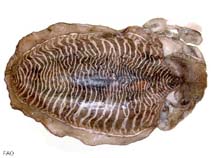Acanthosepion pharaonis (Ehrenberg, 1831)
Pharaoh cuttlefish
Classification / Names Common names | Synonyms | CoL | ITIS | WoRMS
Cephalopoda | Sepiida | Sepiidae
Environment: milieu / climate zone / depth range / distribution range Ecology
Benthic; depth range 0 - 130 m (Ref. 1695), usually ? - 40 m (Ref. 275). Tropical; 41°N - 26°S, 32°E - 151°E (Ref. 1695)
Distribution Countries | FAO areas | Ecosystems | Occurrences | Introductions
Indo-West Pacific and the Mediterranean Sea: from Red Sea to Japan and Australia.
Length at first maturity / Size / Weight / Age
Maturity: Lm 12.2, range 5 - 24 cm Max length : 43.0 cm ML male/unsexed; (Ref. 275); 33 cm ML (female); max. published weight: 5.0 kg (Ref. 275); max. published weight: 5.0 kg
Common sizes in landings range from 15 to 20 cm (Ref. 3722). This species supports industrial or artisanal fisheries throughout its range. Mostly fished and abundant in Gulf and the Andaman Sea. This species has been grown successfully in culture and techniques are being developed to culture the animals commercially (Ref. 1695). Minimum depth from Ref. 103582. Benthic (Ref. 105085). Epibenthic (Ref. 116259). Most common in shallow coastal waters (Ref. 801). Commonly found over sand and seagrass beds (Ref. 102838). Active predator and exhibits cannibalism (Ref. 105085). Feeds on crustaceans, small fish (Refs. 801, 9773) and cephalopods (Ref. 105085). Able to change color rapidly (Ref. 102838). Coastal demersal. Forms groups during spawning at depths of at most 20m (Ref. 9773).
Life cycle and mating behavior Maturity | Reproduction | Spawning | Eggs | Fecundity | Larvae
Members of the class Cephalopoda are gonochoric. Male and female adults usually die shortly after spawning and brooding, respectively. Mating behavior: Males perform various displays to attract potential females for copulation. During copulation, male grasp the female and inserts the hectocotylus into the female's mantle cavity where fertilization usually occurs. Life cycle: Embryos hatch into planktonic stage and live for some time before they grow larger and take up a benthic existence as adults.
Main reference
References | Coordinator | Collaborators
Jereb, P. and C.F.E. Roper (eds.). 2005. (Ref. 1695)
IUCN Red List Status (Ref. 130435)
Data deficient (DD) ; Date assessed: 18 March 2009
CITES status (Ref. 108899)
Not Evaluated
CMS (Ref. 116361)
Not Evaluated
Threat to humans
Human uses
Fisheries: commercial; aquaculture: commercial; aquarium: potential
| FishSource |
Tools
More information
Internet sources
BHL | BOLD Systems | CISTI | DiscoverLife | FAO(Publication : search) | Fishipedia | GenBank (genome, nucleotide) | GloBI | Gomexsi | Google Books | Google Scholar | Google | PubMed | Tree of Life | Wikipedia (Go, Search) | Zoological Record
Estimates based on models
Preferred temperature
(Ref. 115969): 24.6 - 29.1, mean 28.1 (based on 1516 cells).
Resilience
(Ref. 69278):
High, minimum population doubling time less than 15 months (K=0.46-1.69).



